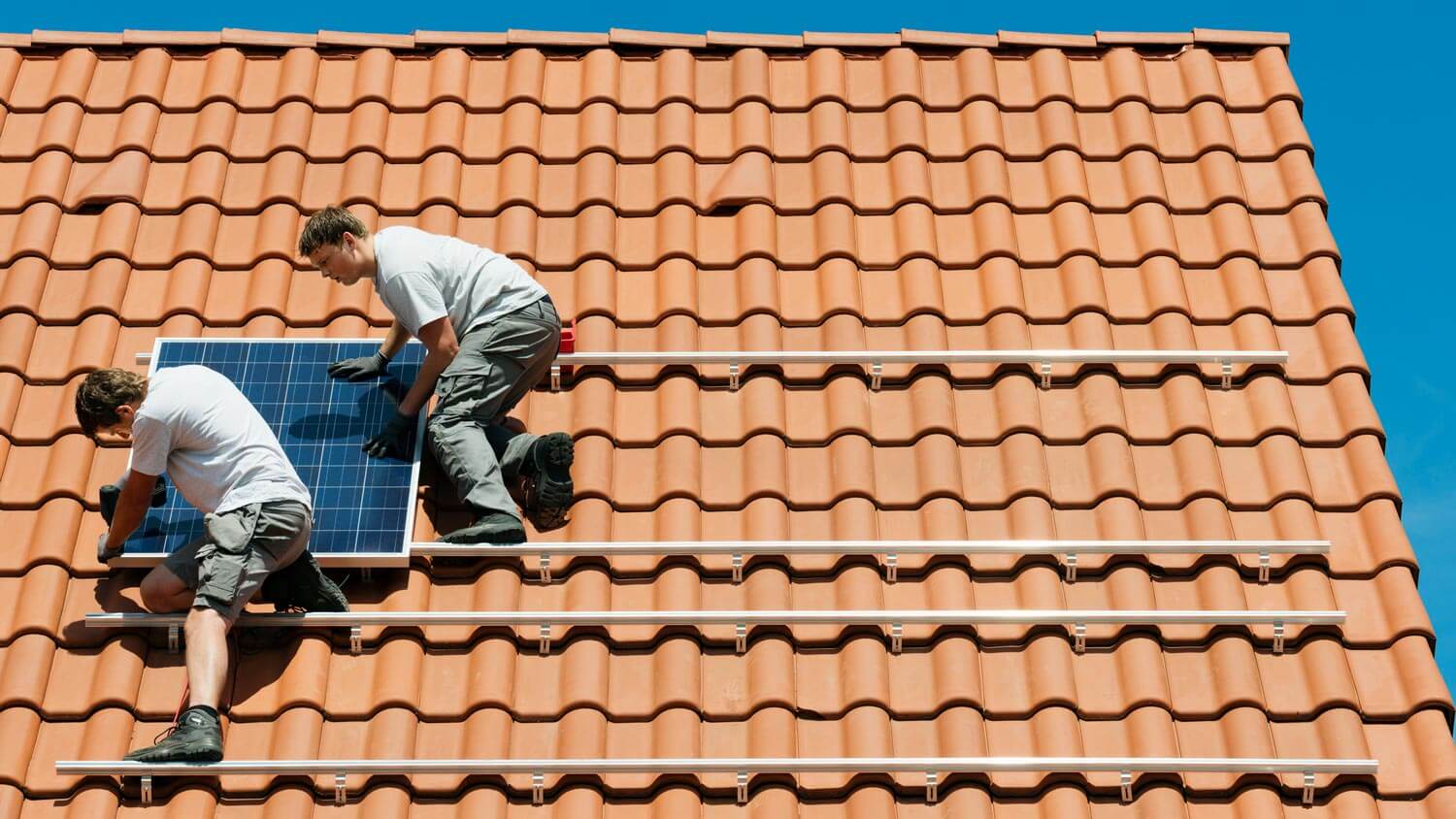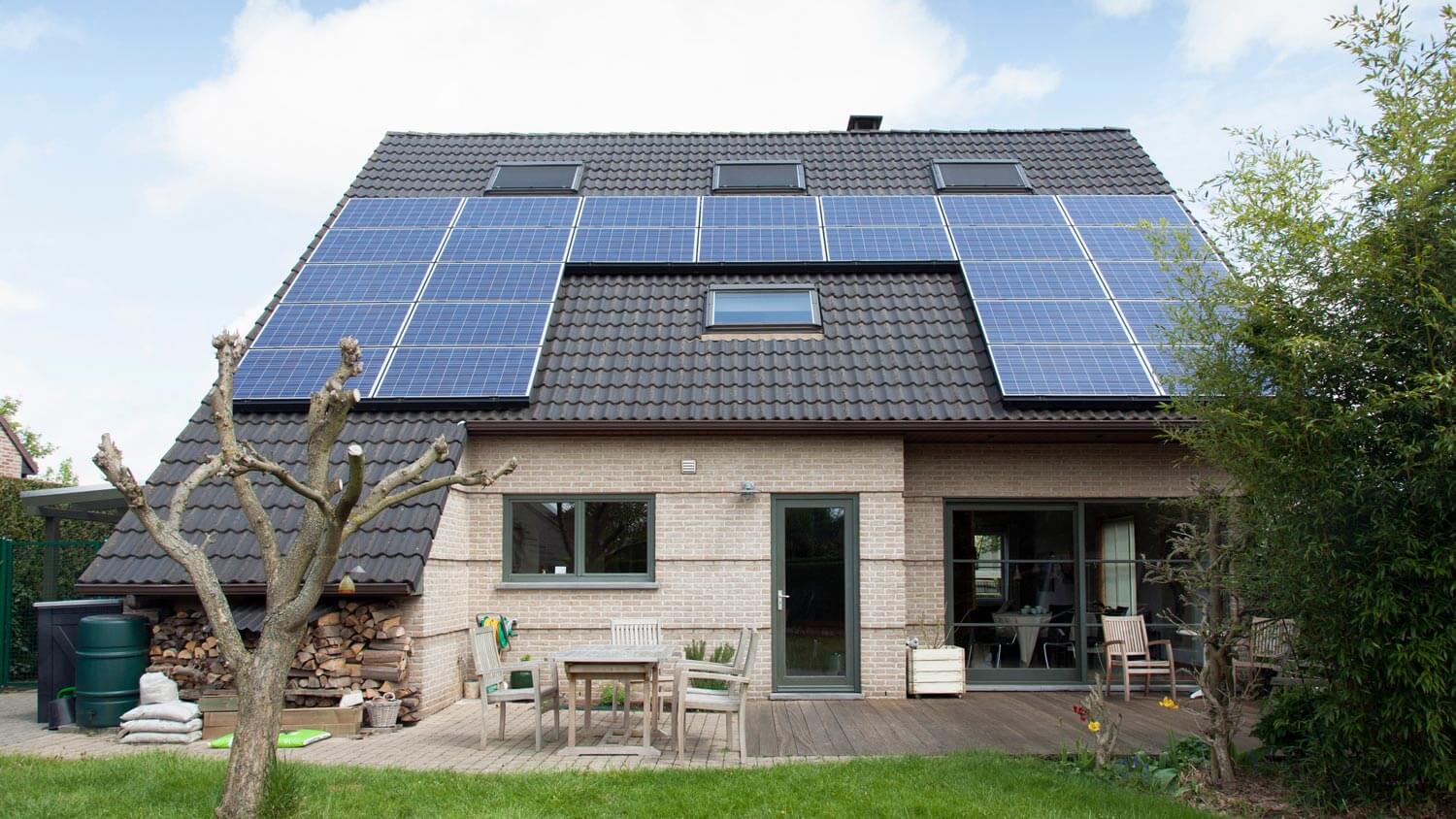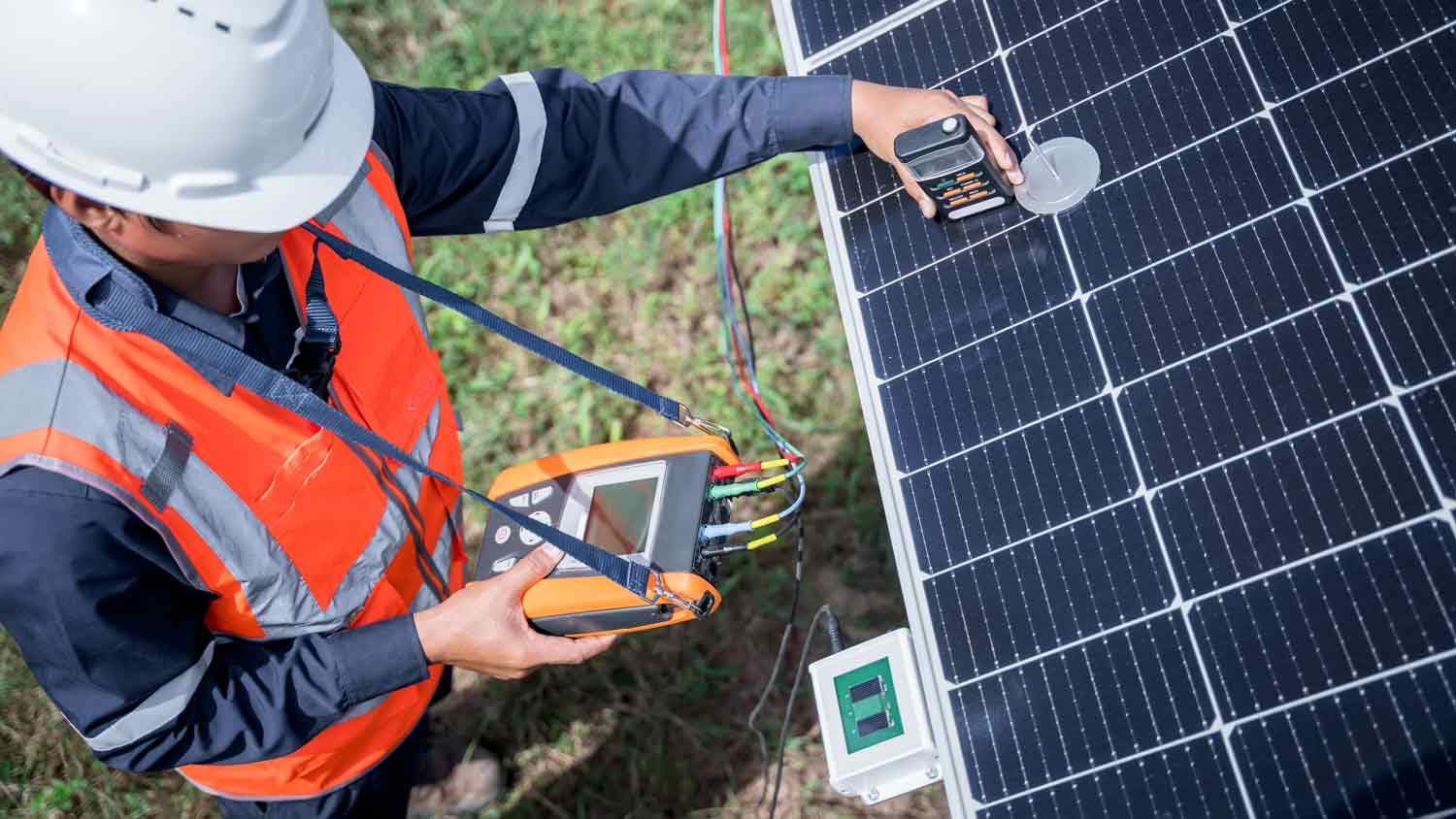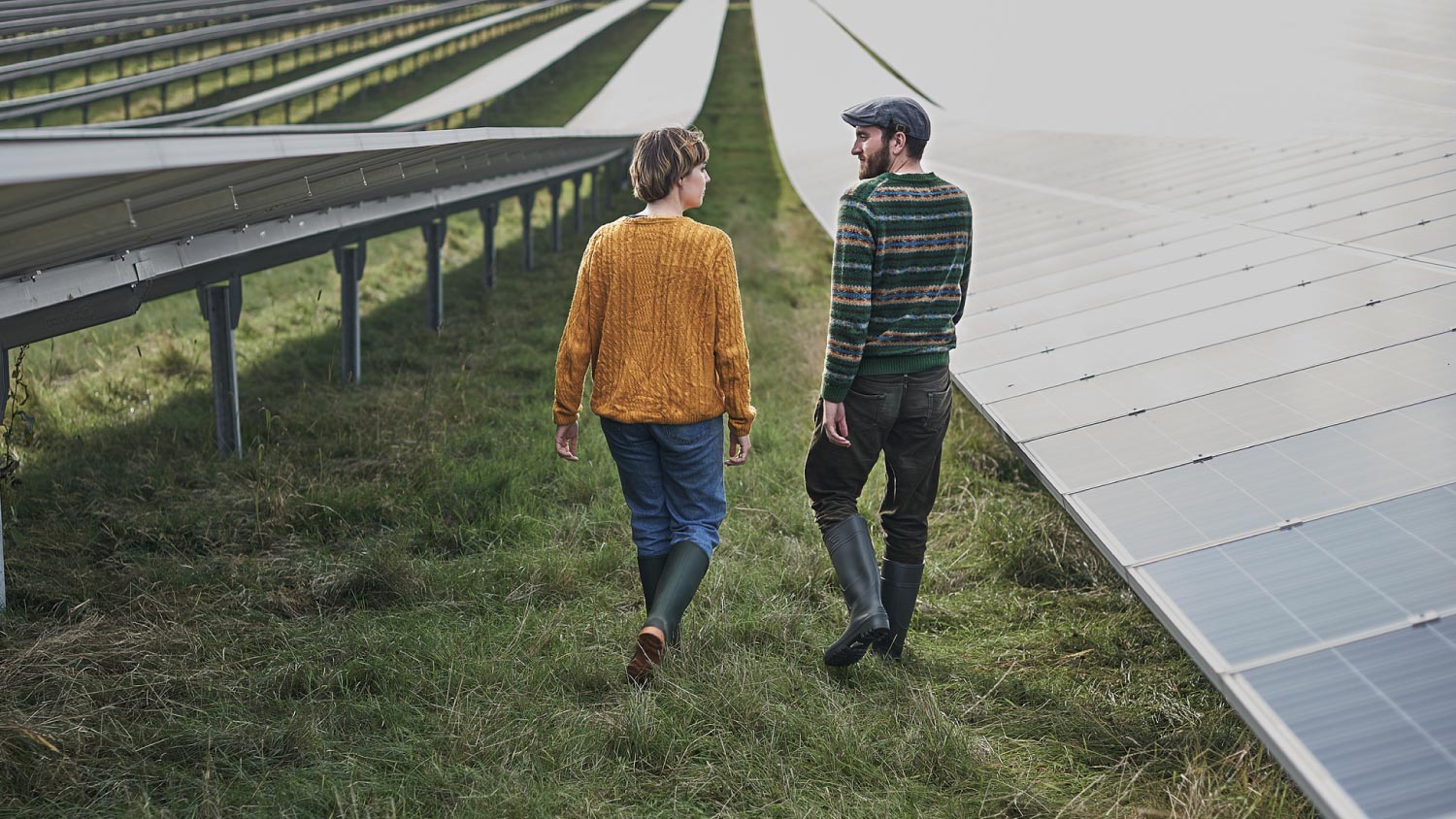
Solar battery costs depend on the size of your system, labor, and capacity. Learn how much you could pay for batteries for home solar systems.
Charge up your savings by choosing the right solar system


Grid-tied solar lets you hook up to the local power grid.
With grid-tied, you can be reimbursed for excess solar energy.
Stand-alone solar isn’t connected to the local grid.
Stand-alone tends to cost more because you need to pay for battery storage.
You can opt for hybrid solar, which ties to the grid and has a battery backup.
Solar power is great for the planet, reduces your home's carbon footprint, and lowers your energy bills. But which type of system do you need? For the biggest payback, grid-tied solar is the better choice. On the other hand, for total energy self-reliance, stand-alone systems are best. And then there's the hybrid system, which combines aspects of both options.
Explore the three types of solar energy systems to figure out which one is right for you: grid-tied, stand-alone, or hybrid.

With grid-tied solar, the solar setup on your property is directly connected to the local power grid. There are no batteries or energy storage requirements, as excess energy gets stored in the local energy network.
With grid-tied systems, if there's no solar energy available from your home setup, you can still draw regular grid power. And, if it's nice and sunny, and your panels are creating more energy than your household consumes, then it's fed back to the grid. When allowed, you're reimbursed for the excess energy your solar panels generate, which further reduces your energy costs and helps you recoup the cost of installing solar panels.
Here’s the benefits and disadvantages of grid-tied solar systems to keep in mind.
A grid-tied solar system costs less up front because of federal, state, and local government incentives like multiyear price locks, tax credits, and reimbursement for excess energy contributed to the grid. The price is also lower because a grid-tied system doesn’t require expensive batteries for power storage.
This system can pull power from the grid at night or if poor weather prevents panels from collecting enough solar power. With the panels facing the right direction and various incentives, you can quickly recoup your investment.
Finally, some solar installation companies offer an output guarantee that includes compensation if the system fails to reach the minimum guaranteed output. Contact a local solar panel installation company to price the cost of installation and provide details about potential guarantees.
Regarding the disadvantages, these systems are susceptible to power outages just like any other home on the grid. They also require the grid for nighttime power.
Utility companies take on additional risks by connecting residential solar power systems to the grid. Consequently, a grid-tied system may require liability insurance, fees associated with grid connection, and solar panel inspection fees for new homes.
Grid-tied systems can also be inconvenient if you have other buildings on your property, like a shed or shop. You might have to pay to install addit areional lines to connect each building to the grid.
| Pros of Grid-Tied Solar | Cons of Grid-Tied Solar |
|---|---|
| Lower installation cost | No battery backup |
| Easiest to maintain | If the grid suffers a power outage, so will you |
| Reimbursement for excess energy production | Interconnection agreements can include liability insurance, fees, and more to protect the grid from your home |
| Draw power from the grid when solar panels aren’t generating enough | Some utilities charge a standby fee to offer you backup power when your solar system isn't generating enough |
| Some utility companies offer multiyear price locks when you tie a solar system into their grid. | Separate buildings that don't already have a grid connection, such as a barn or outbuilding, can't be grid-tied unless you also pay for the installation of power cables and connection to the grid |
| No limit on how much energy you can use | |
| Average saving of 50% of energy costs |
Best for:
Those with a smaller budget
Locations where grid-tied solar is readily available
Areas with fewer power outages
With stand-alone solar, your power system is insular and not connected to the local power grid. Instead, the solar panels produce energy that travels through the inverter to a power bank or system of solar storage batteries. Then your home pulls electricity from the battery bank for consumption.
With a large-capacity battery bank, such as multiple Tesla Powerwalls, you can store enough energy to keep your home running for up to a month, including running multiple large appliances, even if your solar panels aren't running at optimum levels. However, if you keep an eye on solar power efficiency, you can keep batteries full and power running.
Stand-alone solar costs more than grid-tied because of the need for battery storage, and you won't get reimbursed for excess energy sent to the local grid. But you will be completely self-sufficient for energy, and you can use a gas generator as a secondary backup and won't be affected by local power outages.
Here are the advantages and drawbacks of stand-alone solar panel systems.
A stand-alone solar power system provides power independence. It doesn’t have to comply with the same regulations and guidelines as those connected to the grid, potentially reducing connection or inspection fees.
A stand-alone system’s power bank or battery can provide power for several days to up to a month, so there’s no loss of power during grid outages. The battery can also provide power at night or when conditions are cloudy. Plus, it’s hard to beat the value of solar panels when you no longer have an electricity bill.
On the downside, the panels for these systems are more expensive to install, as are the batteries themselves. There might be local, county, or state incentive programs in your area to offset these initial installation costs, but the system will still be more expensive than a grid-tied one.
The owner must also stay on top of maintenance for the batteries. Over time, batteries can lose efficiency or break down and need replacement, which can be expensive. Finally, it takes longer to get a return on your investment with a stand-alone system because there’s no reimbursement for excess energy production.
| Pros of Stand-Alone Solar | Cons of Stand-Alone Solar |
|---|---|
| Provides independence and self-sufficiency | Requires battery backup |
| Fewer restrictions without compliance with local grid stipulations | You may also want a generator backup |
| Won't be impacted by power outages and problems with the local grid | Costly to install because of the storage batteries |
| No bills from utility companies | Slower to recoup the value because excess energy is not sold back to the grid |
| Can power any building or area, not just those with existing grid connections | You're responsible for system maintenance |
| Has storage batteries to power your home at night or in poor conditions | Batteries lose efficiency as they age or with lack of maintenance |
| Many incentive programs offset the cost of installing power cell backups | Batteries eventually wear out and need replacement |
Best for:
Homeowners who want power independence
Areas where power outages are frequent
Those with a large budget

A hybrid system is still tied to the grid, but it has a battery backup. So, in the event of a power outage, you still have power to your home via the battery unit. The time to recoup your investment is lower than regular grid systems because the excess solar energy fills your battery backup first, before the overage goes to the local grid. Plus, installing a solar storage system is more costly than a standard tied system.
While these hybrid systems are not meant to go fully off-grid, they can meet the basic power needs of your household for a few days at a time.
Here’s how hybrid solar systems compare to the other options.
Hybrid systems are often the happy medium between stand-alone and grid-tied systems. These systems include a battery to store power, so you don’t lose power during outages, though you can draw power from the grid if needed. However, a hybrid system doesn’t have as large or as many batteries as a stand-alone system.
These batteries only hold enough power for a few days (not up to a month like with stand-alone systems). That offers some, though not full, power independence. Because of the battery, they fall between stand-alone and grid-tied systems when it comes to price.
As far as cons, it takes longer to recoup costs with a hybrid system. A hybrid system can create excess power and qualify for reimbursement from the local utility company. However, there’s less excess because the system charges the battery first.
| Pros of Hybrid Solar | Cons of Hybrid Solar |
|---|---|
| Batteries can power the home at night or during outages | Longer time to get a return on investment |
| Reimbursement for excess power production | Less reimbursement due to charging the battery first |
| Can draw power from the grid if needed |
Best for:
Homeowners who want some but not total power independence
Areas with frequent power outages
These three system types can all save money on energy expenses and create clean power. Here’s how they measure up side-by-side.
Grid-tied systems are the least expensive to install because they don’t require a power bank or battery to store power. Plus, you might be reimbursed for excess energy the system contributes to the grid. These systems are also eligible for incentives, tax credits, and rebates.
Grid-tied systems can be installed by a local installation or utility company, simplifying and reducing installation costs. Plus, grid-tied solar panels don’t require a battery, a charge controller, or a backup gas generator, which can all complicate installation.
The battery of a stand-alone system provides power night or day, rain or shine, and whether or not there’s an electrical outage from the local grid. However, that electrical access is only so far as the capability and condition of the system and battery.
The energy production between systems is relatively similar if the systems have the same number and types of panels. What happens to the excess energy is where they differ. With grid-tied and hybrid systems, you could be reimbursed for the excess energy, while the excess energy is stored with a stand-alone system.
With a stand-alone system, you won’t get a power bill from the utility company, providing power independence.
Stand-alone and hybrid systems offer independent power during local outages. Hybrid systems will keep the lights on for a few days, while a stand-alone system can provide power for up to a month.

A stand-alone system is your best option if you have the budget and want to be entirely energy self-sufficient. If you have a property or a building on your property that isn't grid-connected, you’re in a good position to get a stand-alone system.
But if you’re on a tight budget, even with the available incentives, a fully off-grid system may be beyond your reach. In this case, a grid-tied system makes sense, as it involves less up-front costs and lets you recoup the value of the installation faster by paying you for the excess energy your panels generate.
Similarly, if you don't want the cost and effort associated with installing and maintaining a stand-alone system, a grid-tied system is the better choice.
In areas where storm damage or power outages are common, a hybrid system is a good compromise. With a hybrid system, there's a small battery backup integrated into the setup so that if the local power grid fails, you can rely on the stored energy from the battery to power a few critical circuits in your home for a short time.
From average costs to expert advice, get all the answers you need to get your job done.

Solar battery costs depend on the size of your system, labor, and capacity. Learn how much you could pay for batteries for home solar systems.

Discover the average solar panel inspection cost, what impacts pricing, and how to save. Get expert tips to keep your solar system efficient and safe.

Get a detailed estimate of solar farm costs. Learn about average prices, key cost factors, and ways to save when planning your solar farm project.

Solar batteries allow you to store excess energy from your solar panels, but what are the pros and cons of solar battery storage? We break it all down.

Whether you're going solar or your panels are getting older, you might be wondering if solar panels are recyclable. This guide covers what you need to know.

Is your home a good fit for solar panels? It all depends on your roof, sunlight exposure, and energy bills. Use this guide to find out.